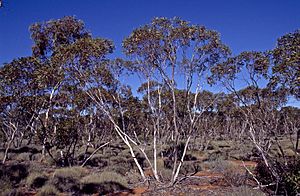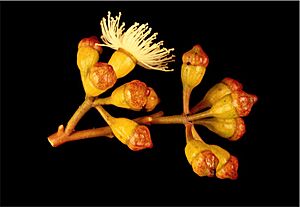Eucalyptus cyclostoma facts for kids
Quick facts for kids Eucalyptus cyclostoma |
|
|---|---|
 |
|
| Eucalyptus cyclostoma near Zanthus | |
| Scientific classification | |
| Genus: |
Eucalyptus
|
| Species: |
cyclostoma
|
Eucalyptus cyclostoma is a special kind of mallee tree. A mallee is a type of eucalyptus that usually has many stems growing from the ground, instead of just one trunk. This plant is found only in a certain area in the south of Western Australia. It has smooth, greyish bark and leaves shaped like a spear. Its flowers are white and grow in groups of seven to eleven. After the flowers, it produces roundish fruits.
What it Looks Like
Eucalyptus cyclostoma is a mallee that usually grows to be about 1.5 to 4 meters (5 to 13 feet) tall. It has a special woody swelling at its base called a lignotuber. This helps the plant regrow after a fire.
Its bark can be whitish-grey, cream, brown, or pinkish-grey. It might be flaky, ribbony, rough, or smooth.
The adult leaves grow in an alternating pattern along the stem. They are dull, bluish-green on both sides and shaped like a spear. Each leaf is about 6 to 10 centimeters (2.4 to 3.9 inches) long and 1 to 1.5 centimeters (0.4 to 0.6 inches) wide. The leaf narrows down to a stalk called a petiole and has a pointed tip.
Flowers and Fruit
This plant blooms between February and April, producing white flowers. The flower buds grow in groups of seven to eleven. Each group is on a main stalk called a peduncle, which is 8 to 20 millimeters (0.3 to 0.8 inches) long. Each individual bud sits on a smaller stalk called a pedicel, which is 3 to 7 millimeters (0.1 to 0.3 inches) long.
When the buds are ready, they are shaped like a cylinder or a pear. They have a beak-like cap, called an operculum, that covers the flower parts. Inside, the stamens (the male parts of the flower) are bent inwards, and the anthers (which hold pollen) are oblong.
After flowering, the fruits form. They are shaped like a sphere with the top cut off, about 0.8 to 1 centimeter (0.3 to 0.4 inches) long and 0.7 to 1 centimeter (0.3 to 0.4 inches) wide. They also sit on a pedicel that is 3 to 8 millimeters (0.1 to 0.3 inches) long. The fruit has three or four openings, called valves, which are almost level with the rim. Inside, the brown seeds are flattened and oval-shaped, about 1 to 2 millimeters (0.04 to 0.08 inches) long.
Its Name and Family
The first official description of Eucalyptus cyclostoma was written by a botanist named Ian Brooker in 1981. He published his findings in a science journal called Brunonia. Brooker had collected a sample of the plant near Balladonia in 1970.
The second part of the plant's scientific name, cyclostoma, comes from two Ancient Greek words. Kyklos means "circle" or "ring," and stoma means "mouth." This name refers to the clear rim around the fruit, which looks like a mouth or ring.
Eucalyptus cyclostoma belongs to a larger group of eucalyptus plants. It is part of a series called Ovulares, which includes nine closely related species. Some of its relatives have smooth bark, like E. cylindrocarpa and E. exigua. Others have rough bark, such as E. ovularis and E. aequioperta.
Where it Grows
This type of eucalypt is found only in a specific area of Western Australia. It grows on limestone plains in the south-western Goldfields-Esperance region. You can find it in sandy loam or red sand soils.
Eucalyptus cyclostoma has a small native range, mainly around the towns of Balladonia and Zanthus. In these areas, it grows as part of low woodland communities, which are forests with shorter trees.



